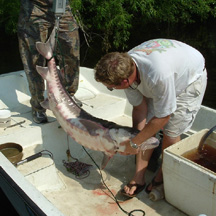Diadromous Fish Research

Photo by Duane Raver, USFWS
Atlantic Sturgeon
Acipenser oxyrinchus
The Atlantic sturgeon is listed as endangered and all fisheries for this species have been closed in the United States. It occurs along the Atlantic coast of the U.S. and Canada in major rivers and the coastal ocean. This is an anadromous species under the jurisdiction of the National Marine Fisheries Service and the Atlantic States Marine Fisheries Commission. The Atlantic sturgeon is one of the larger sturgeons, attaining up to 9 feet in length and several hundred pounds. Large females were heavily fished due to the value of their eggs (caviar), and poaching is a problem in some areas. The only other species of sturgeon with an overlapping range is the shortnose sturgeon, Acipenser brevirostrum.

the Edisto River.
Photo by Ivy Perry
Because juvenile Atlantic sturgeon leave their apparent natal river at 2-5 years of age and may wander extensively, visiting other rivers and estuaries, direct evidence for existence of a population in a specific river requires capture of very young fish (age 0-1) or mature fish on the spawning grounds.
In South Carolina there appear to be populations in the Savannah River, one or more of the rivers flowing into St. Helena Sound (Ashepoo, Combahee, and Edisto Rivers), the Santee River, one or more Winyah Bay rivers (Pee Dee, Waccamaw, and Black), and probably the Cooper River. For more information contact Bill Post.
